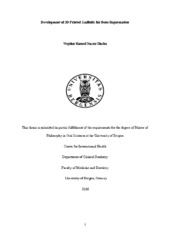Development of 3D Printed Scaffolds for Bone Regeneration
Master thesis

Åpne
Permanent lenke
https://hdl.handle.net/1956/13006Utgivelsesdato
2016-05-24Metadata
Vis full innførselSamlinger
Sammendrag
The 3D printing process can produce bioengineered scaffolds with a 100% interconnected porous structure layer-by-layer with the help of computer-aided design. In this study we utilized a 3D bio plotter system to fabricate 3D interconnected porous scaffolds for bone tissue engineering. Poly (L-lactide-co-caprolactone (PLCL)) was selected to fabricate the scaffold due to its biocompatibility and printability. Two scaffolds were produced for comparative study with a layer rotation of 45° and 90° and a distance of either 1000 µm or 1200 µm between the printed fibers. Micro computed tomography (µ-CT) was utilized to study the interconnected porous structure of the scaffolds. Protein adsorption on the surface of the scaffolds was examined using a protein assay kit. Human osteoblast-like cells (HOB) were seeded onto the two different scaffolds and cellular activities (attachment, morphology, and proliferation) were investigated using scanning electron microscopy (SEM), live/dead stain, lactate dehydrogenase enzyme (LDH), and methylthiazol tetrazolium (MTT). Gene expression of apoptotic (Bax and Bcl2) and osteogenic markers (ALP and OC) were investigated by qRT-PCR. The µ-CT results confirmed the open porous structure of the two scaffolds and no significant difference was found in protein adsorption between the two designs. SEM, LDH and MTT analysis confirmed that HOB cells adhered, spread and proliferated well on both scaffolds. The qRT-PCR analysis showed that cells seeded on the scaffold with 1200 µm between the fibers expressed higher mRNA levels of Bcl2 (day 1, 3, 7 and 14), ALP and OC than cells seeded on the scaffold with 1000 µm between fibers (day 14). In conclusion, the newly designed 3D printed scaffolds are biocompatible with HOBs, and no adverse effect on cell attachment and proliferation was seen. Rather, enhanced osteoblast proliferation and differentiation were seen using the scaffold with 1200 µm between the printed fibers. Therefore, 1200 3D printed poly (L-lactide-co-caprolactone) scaffolds may be suitable candidates for bone regeneration. Recently, the use of 3D bio-plotter system has been used in tissue engineering . Different designs of the 3D scaffolds, different angles of rotation (45° and 90°), and scaffold characteristics have been shown to promote initial cell attachment and differentiation. Therefore, the aims of this study was to evaluate 3D printed scaffolds for bone tissue engineering (BTE) using two modified 3D printed scaffolds with different pore size (1000 µm and 1200 µm) and to investigate the effect of these scaffolds on cell viability, attachment, proliferation and differentiation.The results showed that the 3D scaffolds are not cytotoxic, are biocompatible and do not have an adverse effect on the attachment and proliferation of HOBs in vitro. Moreover, the 1200 µm scaffold enhanced proliferation and expression of osteogenic markers by HOBs compared to the 1000 µm scaffold in vitro. Therefore, the 1200 µm 3D printed scaffold appear to be appropriate carriers for bone engineering investigations and regeneration.